Text
Hi Natalie,
I really enjoyed your post for several reasons. You mentioned that the power of storytelling plays a huge role in nature interpretation for authenticity, empathy, and experiential learning. I agree with you that storytelling can create a sense of emotion with visitors or learners that can allow them to take in information and form a connection to it.
You also mentioned that your beliefs play a huge role in how you interact with nature around you. I believe that this is a huge part of how we view the world around us and impacts how we relay information to others. If we dont believe what we are interpreting is important, how will we ever convince anyone else? It's important to reflect on our values and beliefs ahead of time so that we can clearly communicate to others how we feel and why we feel that way.
You mentioned that you see a great importance in the ability to create connections between people and the natural world. I also agree with this because visitors come to nature interpreters looking to learn, looking to be educated, while experiencing unexpected new valuable connections with their surroundings. It's our role as nature interpreters to facilitate this connection. Like you said, invoking a sense of wonder, asking thoughtful questions and engaging stories are all great ways of forming connections.
I could see you developing more podcasts in the future, relaying important information via storytelling to create connections between listeners and nature.
Thanks for sharing!
Lea
Unit 10: A reflection on my Personal Ethics as a Nature Interpreter
Hello fellow interpreters,
For my final blog post for this course as a nature interpreter, I bring with me a set of beliefs, responsibilities, and approaches that guide my interactions with the natural world. This final blog serves as a place of reflection on my changing beliefs, the responsibilities I uphold, and the approaches that I find the most suitable for me as an interpreter (Beck et al. 2019, Chapter 4). Taking inspiration from ideas in the textbooks and course material I plan on applying my values and insights into meaningful actions in the world of nature interpretation.
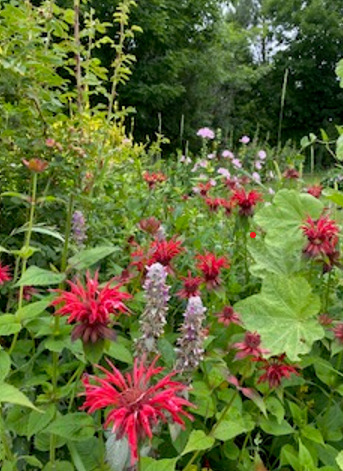
Starting with my beliefs, as a nature interpreter I believe that nature has a greater purpose than just its practical uses. I believe that nature possesses great value and worth, and it deserves our respect and protection. Thinking back to when I was a kid, my beliefs about nature have developed for the better as I became more educated on the topic over my academic career. For example, as a kid I only knew nature from what I had experienced, which included going on family camping trips, going on hikes, and playing outside with friends. I would say my view of nature at this time was that it provided a space for me to engage in activities and I didn't understand how much value it held. Now that I am older and more developed, I have learned a lot about the environment, I understand how much it shapes our day-to-day life, our mental health, our physical health, self-esteem, and many more (Beck et al. 2019, Chapter 3). After learning about many aspects of nature I understand that it is far more than a resource for human consumption but a complex and interconnected web of life that sustains us all (Beck et al. 2019, Chapter 3). By recognizing and honoring the value of nature, we can build a deep sense of appreciation and stewardship for the world around us (Dr. Hooykaas, n.d.).
Secondly, as a nature interpreter, I understand the responsibility that comes with the role of creating connections between people and the natural world. In this role, I am tasked with creating understanding, appreciation, and stewardship of the environment while also advocating for conservation and sustainability practices (Dr. Hooykaas, n.d.). This responsibility is exemplified through my exploration of communication and experiential learning theories in this course, which have equipped me with tools to effectively communicate important information on nature to diverse audiences (Beck et al. 2019, Chapter 5). Just like interpreters help people develop an ethical sense of their place and role in the world, my goal is to create a similar sense of connection and responsibility toward nature in future generations (Beck et al. 2019, Chapter 3; Jacob Rodenburg, 2019). Inspired by Tilden's goal of creating transformative experiences through interpretation, I am committed to providing engaging stories, asking thought-provoking questions, and evoking a sense of wonder and appreciation for the natural world in all those I encounter. Take the children's podcast we recently completed as an example, we focused on environmental education, where I put my interpretive skills to use to engage young listeners in topics such as biodiversity, conservation, and the wonders of the squirrels in the arboretum. Through projects like these, I plan to fulfill my responsibilities as a nature interpreter by inspiring curiosity, and compassion, and creating a sense of environmental responsibility in future generations (Dr. Hooykaas, n.d.).
When dissecting naturing interpretation, I tend to favor approaches that focus on authenticity, empathy, and experiential learning to interact with visitors. Through the content of this course, I believe that the power of storytelling is a great way to create deep connections using tales that make sense to the lives of participants as the medium to convey messages of unity and empathy (Beck et al. 2019, Chapter 10). Using interactive and story-telling techniques that captivate the senses and provoke emotional responses, I intend to promote an interest in nature and motivate action in the people I come across. I see the importance of meeting people where they are in their journey of life so that I can adapt easily to their interests, backgrounds, and developmental stages.
As an individual, I have learned through this course that I am a visual learner and that I tend to use approaches that emphasize hands-on experiences and visual aids. I believe in the power of storytelling and how it captures the imagination and interprets complicated ideas in a relatable way. By incorporating visuals, such as photographs, diagrams, and props, I can help others who are visual learners as well by enhancing their learning experience and making complex concepts more manageable for participants. Throughout this course, I have noticed the importance of creating inclusive and welcoming environments for everyone so that they feel comfortable and engaged. Whether I am leading an interpretive walk, holding a workshop, or creating interpretive material, I will always make sure that my approach meets the diverse needs and preferences of my audiences, to make sure everyone can connect to nature in a meaningful way (Beck et al. 2019, Chapter 6).
Overall, as I reflect on my journey as a nature interpreter, I am reminded of how big of an impact my beliefs, responsibilities, and approaches have on shaping the interactions made with the natural world. By being more mindful and searching within myself, I have gained a better appreciation of the inherent worth of nature and the connections between all life. The ongoing changes in my personal beliefs lay a foundation for my future nature interpretation responsibilities which include, building understanding, appreciation, and stewardship of the environment, while still advocating for conservation and sustainability practices (Dr. Hooykaas, n.d.). From creating educational materials to interacting with various audiences, I am dedicated to the goals of accurately describing ideas, empathizing with the audiences, and experiential learning in the process. By creating memorable narratives using storytelling, pictures, and inclusive practices, I hope to create transformative experiences that inspire curiosity, and compassion, and create a sense of environmental responsibility in all who cross my path. As I continue my journey as an interpreter, I am grateful for the knowledge I have gained and look forward to applying it in practice, ensuring that nature's interpretations remain a powerful tool for connecting people with the natural world. Together as a class, let us embrace the wonders and beauties of nature, and strive to be stewards of the earth we call our home.
References
Beck, L., Cable, T. T., & Knudson, D. M. (2018). Interpreting Cultural and Natural Heritage for a Better World. Sagamore Publishing. https://www.sagamorepub.com/products/interpreting-cultural-and-natural-heritage-better-world
Jacob Rodenburg. (2019, July 17). Why environmental educators shouldn’t give up hope | CLEARING: PNW Journal of Environmental Education in the Pacific Northwest. https://clearingmagazine.org/archives/14300
Hooykaas, A. (n.d.). Unit 10: Nature Interpretation’s Role in Enviornmental Sustainability [Lecture notes]. ENVS3000 Nature Interpretation. University of Guelph.
4 notes
·
View notes
Text
Hi Heather,
I enjoyed reading your post, which is filled with enthusiasm regarding nature interpretation and your aspiring goals. I hope your experience in Newfoundland this summer is filled with new experiences that will bring you new knowledge and fun.
I have the same beliefs as you, that conservation and protection are my main priorities. I have always been very environmentally friendly and pro conservation since I was young. In elementary school, I started a recycling committee with the help of my grade 3 teacher. We made posters with reasons on why to recycle, met weekly to sort through the recycle bin to make sure everything was properly recycled and I proudly flaunted my role. I have always been invested in doing my part in reducing waste and recycling for the planet. Everyday I see new initiatives from others about how they are helping the environment. My instagram explore page is filled with people thrifting clothing rather than buying new fast fashion, people making their own backyard gardens to reduce buying exported fruits and veggies, people using glass containers for coffee dates rather than plastic cups, and so much more. It's nice to see that other people from around the world have put an effort in to help the planet. Lets hope it continues.
It's inspiring to hear that your passion to work with children can be translated into nature interpretation. To work with young minds and be able to influence/teach the aspects of nature can allow them to understand the importance of their role as the next generation.
Thanks for sharing and goodluck on your future endeavours.
Lea
The role of a life time
Welcome to my blog,
As someone pursuing a future in nature interpretation, my priority will always be the protection and conservation of nature. There is no future in nature interpretation if there is no nature to interpret. This has always been a belief I have carried and will continue to carry for the rest of my life. My second priority will be people. Throughout this course we have learned about the importance of sharing the beauty of nature with others, and all the ways this can be done. Aside from my responsibility to nature itself, my responsibility to the public is another major driving factor in my life. Ensuring that as many people as possible understand the importance of the natural world and form their own personal attachments to protect it in the future.

Right now, I am a student. I have only just started my journey as an adult and am unsure of who I am. However, I have developed several core beliefs that I will continue to adapt and build upon. I believe in the significance of nature, and I believe that as humans we can change. We have long taken the natural world for granted, seeing it as a commodity or something to be owned. We are a part of nature, just one cog in the cycle, we are not separate or above any other part of nature, and as soon as we understand that, change can occur.
Rodenburg (2019) says that he wouldn’t do the work he does if he didn’t believe in impact experiences in nature can have on people. I think most nature interpreters would agree. I want to pursue this week because I have experienced the significance of nature myself and have been changed by it. And I wish to share the love I have for nature with as many people as possible. I find myself drawn to working with students. Young kids who will one day have the responsibility of fixing the world that was left to them. In a world of increasing technological advances, it is becoming easier to keep kids inside instead of urging them outside (Rodenburg, 2019). It falls to the hands of teachers and interpreters to ensure that kids are creating meaningful experiences in nature so that one day they’ll make better choices when it comes to protecting nature. This is one of my goals that I hope one day I will achieve.
One of the most impactful things I read in our textbook, was that each interpreter is responsible for continuing their own learning and seeking resources to better themselves (Beck & Cable, 2018). Every class I’ve taken, have helped me get to where I am today. Even the ones that weren’t specific to my major, helped me learn more about the world and apply it to my own experiences and build new skills.
Beck & Cable (2018), remind the reader that becoming someone (as an interpreter) takes time. They discuss how one needs time to travel, to read, to learn, to watch and to contemplate one’s life and work (Beck & Cable, 2018). I have only just started my journey. The beliefs I have now are strong, and good place to start, but I need time in the real world to create my own experiences and find out who I am in order to be a good interpreter.

One thing I will take with me from this course, is that there is no one way to interpret. Throughout the semester we learned that one can interpret through art, science, history, music and more (Hooykaas, 2024). Art was a newer idea for me, growing up art and science always seemed so separate. But here I learned how easy it is to integrate art, science, and history together, to make a better story. Wheeler (2016) taught us that art helps us create richer experiences for our audience. Music has a similar affect, Gray et al (2001) remind us that every culture has some form of music, it is universal. Music can also be found in nature, through birds, whales, rain, wind, and more. The idea of the windchime, where human invention and nature mingle is an example of ways people interact with nature, maybe without even fully realizing it.
Right now, I prefer a more hands on approach in my role as an interpreter. I enjoy being out in the field with students and showing them the wonders of nature. I find that my excitement transfers best when it’s authentic and that happens when I’m out in nature. As a visual learner I know how difficult it can be to keep up with someone who’s simply talking to you. This is where I find hands-on experiences most helpful. Obviously oral communication is one of the most common forms, but it can be hard to absorb all that knowledge, by slowing down and looking at something together, it presents the opportunity for the student to see what it is you’re talking about and ask questions in a judgement-free environment. I learned a while ago to not be scared of asking questions and it’s something I urge for others to do as well. If you don’t ask, you’ll never learn.
I will strive to continue educating myself on environmental topics, this way I will have a solid background when presenting environmental sciences to the public/students. I’m going to continue to adapt my interpretation skills and incorporate music, art, and history into my science background. I strongly believe that in order to be a great interpreter, I need to continue to learn. To expand my horizons and understand more of the world.
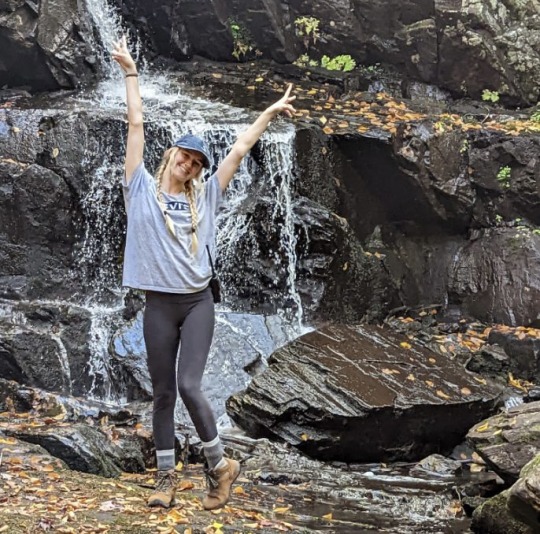
This summer, I’ll be venturing off to Newfoundland for 4 months to work at a research institute as a marine interpreter. I will 1000% be applying the knowledge I’ve learned from this class, as well as all my other course, and past work experience. Beck & Cable (2018) mention travel as a way to better oneself, and I have the privilege of getting to embark on a journey to figure out who I want to be. Aristotle said, “knowing yourself is the beginning of all wisdom.”
I’m excited to find out who I am.
That’s all!
References
Beck, L., Cable, T. T., & Knudson, D. M. (2018). Interpreting cultural and natural heritage: For A Better World. SAGAMORE Publishing.
Gray, P. Krause, B. Atema, J., Payne, R., Krumhansl, C. & Baptista, L. (2001). The Music of Nature and the Nature of Music. Science. 291. 52-54.
Hooykaas, A. (2024). Unit 07, Unit 04, & Unit 10. [Lecture notes]. ENVS3000 Nature Interpretation. University of Guelph.
Rodenburg, J. (2019). Why Environmental Educators Shouldn't Give up Hope. Environmental Literacy. ClearingMagazine.org.
Wheeler, E. (2016). The craft of engagement. Legacy, 27(6), 29–31.
3 notes
·
View notes
Text
Unit 10: My beliefs & role as a nature interpreter
Through this course we have learned what it is to be a nature interpreter. To be insightful, to guide others and to inform curious minds about the beauty of nature while maintaining our own beliefs on what the role entails. My beliefs as a nature interpreter could be determined as ethical based, where I understand that every non-human being within our planet has moral rights. Every plant that grows has the right to be undisturbed, protected and advocated for. Insect that marches the forest has the right to explore, interact and live without being disrupted. Every mammal, reptile, avian, fish and amphibian has the right to be as they are, while remaining a source of education for us. Elements such as soil, sun, wind and rocks have the right to be as they are, undisturbed.
My beliefs are that all of these non-human beings have no ways of verbal communication and therefore we must be their active voice. We are nature interpreters who have the ultimate role of informing people about nature and allowing them to understand the importance of conservation and protection of our beautiful planet. To fight for the rights of animals, plants and the environment. In such a way we are activists for nature.
As I reflect on our semester together, I am reminded that everyone has very unique outlooks on nature. Perception plays a key role in nature interpretation because some people may have a different view on nature’s importance. To me, I believe that we are visitors on this planet and we must leave things as we have found them. We don't get another planet so I think it's essential to provide care for our planet and all its inhabitants, whether that be through conservation, animal rehabilitation or education. Nature has a lot to offer, through music, art, and education but we must all understand that we cannot take advantage of it. It's a gift to be surrounded by such natural beauty. Sometimes, I think we forget that the forest behind our house is not just a boring old forest. It's an ecosystem that houses many animals, insects and plants. A rotting tree trunk can be a new source of life for bacteria and fungi, while a pond can be a home to frogs, ducks, fish and more. Learning to appreciate what we are surrounded with can help understand the importance of it.
We have learned that teaching others about nature’s wonders is a gift. We are provided with information to be passed on to others through interpretive walks, blog posts, and podcasts. As interpreters, we are tasked with the duty of enriching people’s experience with nature (Beck et al., 2018). Interpretation allows people’s cognitive domain to be activated which affects the way people process information, affective domain which is the way people feel towards a subject, and kinetic domain which is the way people use their motor skills to learn (Beck et al., 2018). Adapting our teaching styles to the various learning styles can help a variety of people. For example, if I was to conduct an interpretive walk through the arboretum to learn about different tree species, I would point out the different leaves shapes, colours and textures. I would let learners touch the leaves or bark to actively teach the difference and I would talk about what makes each species unique. All of these things cater to the three learning styles, visual, kinetic and auditory (Beck et al., 2018). It's important to understand that not everyone learns the same as ourselves so catering to others will help get a broader range of learners.
While teaching about nature, it's important to understand how inclusivity plays a role. Remaining inclusive to age, gender, soci-economic status, learning-styles and disability is key to delivering information to learners in a safe space. By doing so, we are letting people know that they are welcome in nature and it can be a safe space for each. Additionally, we must reflect on our experience with privilege and how it contributes to the learner’s experience to remove barriers. We must not forget that we constantly carry around an invisible backpack with our experiences and knowledge, adding to privilege. Some people may not have the biological science or environmental science background as we do so we should always remain inclusive by reducing the scientific terms, including metaphors, using easy to understand language, and answering questions.
This course has taught me that risk versus reward is an important piece in nature interpretation (Beck et al., 2018). Learning to take safe risks while remaining vigilant of the imposing threats. Would it be safe to wander from the trail during an interpretive nature walk? Or could there be threats like poison ivy. Is there a way to make risk taking more effective to the learning experience without putting learners at health risk. Some risks are not worth taking, simply for the educational experience. Clearly communicating impending risks to learners is essential. Educating people on the dangers we might be exposed to and how to avoid them can further promote their experience and let them feel part of a safe environment.
I believe that my responsibility as a future nature interpreter is to grow the curious minds of learners. I would like to invite people to step out of their comfort zones and learn about nature’s wonders. I want to add some thrill and excitement to nature while being informative about its inhabitants like plants and animals. It's important to notice that science and environmental science can be intertwined into an art form of nature teaching (Wals et al., 2014). The combination of both allows people to understand the science behind current issues like climate change while educating them on the importance of maintaining food webs and ecosystems during climate change. We can inspire people to see the issues nature currently faces and push them towards being part of the resolution.
I am eternally grateful for a course like this that has opened my eyes to my upcoming role as a nature interpreter. It has allowed me to find my passions while teaching me how to communicate my beliefs effectively to listeners. Ive included some pictures of my favourite experiences in nature. I look forward to having more
Bye for now.
Lea



References:
Beck, L., Cable, T. T., Knudson, D. M. (2018). Interpreting cultural and natural heritage: For A Better World. Sagamore Publishing.
Wals, A. E. J., Brody, M., Dillon, J., Stevenson, R. B. (2014). Convergence Between Science and Environmental Education. Science, 344(6184), 583-584. https://doi.org/10.1126/science.1250515
3 notes
·
View notes
Text
Hi Alleeya,
I really enjoyed your take on this week’s blog post. I am sorry to hear about your family’s experience with cancer history. Your interest in human nutrition surrounding plants and their benefits is clear from your blog post. I can tell that you are seeking information on plant benefits and are intent with what you eat.
We all consume food every day, yet many of us lack a comprehensive understanding of its effects on our bodies. I think nutrition is a subject that everyone should take because understanding what you eat and how it will affect your body is essential. We could also learn about which foods to consume and which to stray away from. I have not taken any nutrition classes so far but I am deeply interested. I haven't heard of the term phytonutrients before, but it is interesting that the colour of the fruit represents their beneficial nutrition.
Genetic engineering of plants could cause detrimental effects like you mentioned because the plants would be made with artificial preservatives, decreasing health benefits. I believe that we will be seeing more genetic plant engineering due to cost and increased production.
Thank you for being a nature interpreter for plants!
Lea
Plant chemicals are so cool! Unit 9
The most amazing thing I know about nature is the ability of plants to produce compounds that serve incredible health benefits to humans. I think it is other-worldly that the flora that has existed alongside humans for so many years can provide us with so many cures to various ailments. Getting personal, I have a very unfortunate family history containing cancer, diabetes, and immune deficiencies that has taken a lot from me. These devastating occurrences have made me all-too-aware of the impacts that lifestyle and food have on human health, and in many ways being in science does not ease my anxieties. However; learning about plant secondary metabolites that serve as phytonutrients in the human body has made me hopeful and inspired to learn more, not just for interest, but to serve my health as well. Buckle up for many science terms and lots of plant facts that I have stored in my brain through my academic career!
Throughout my summary on plant phytonutrients (plant compounds that serve proven health benefits in humans), I will strive to present this information as a whole by connecting plants to human health to satisfy some of Tilden's Principle's of Interpretation (Beck et al. 2018, p. 84). Did you know that the colour of the fruits and vegetables you eat actually correlate to their nutrition? The different pigments produced in plants, such as your orange carrots and red peppers, are caused by secondary metabolites. Orange colouring is caused by the production of beta-carotene, this is then utilized by our body to make vitamin A, making it crucial to our health because we cannot synthesize this on our own. Colours such as purple and dark reds are caused by anthocyanins, these are compounds that aid in our bodies ability to fight tumour producing cells. Actually many plant metabolites, such as glucosinolates from Broccoli, aid in tumour-suppression and have anti-inflammatory properties. Spices such as turmeric have been used for centuries as a treatment for inflammation and diabetes due to the compound 'curcumin'. This bioactive molecule has been increasingly applied to modern medical studies due to its efficacy in improving glucose regulation and suppressing various cancer cell formations.
I won't add in too much more, as I know that was a lot of information. One more area I do want to touch on is the use of genetic engineering to increase yields/improve taste, but decreasing health benefits in the process. An example of this is removing the class of compounds "cucurbitacins" from common cucumbers due to the bitter taste it gives them. These compounds provide various health benefits such as anti-inflammatory and anti-cancer effects, and through the removal of these it has made cucumbers far less beneficial to our health.
I believe much of what our bodies need is provided by nature, not to say I disprove of modern medicine in any way, but our values in food as a society has been greatly impacted due to prices/availability. I want to work plants to improve nutritional concentrations of food, and helping humans be healthier through what has already been granted to us by nature.
Thanks for reading!
Alleeya
Beck, L., Cable, T. T., & Knudson, D. M. (2018). Interpreting Cultural and Natural Heritage: For A Better World. Sagamore Publishing.
7 notes
·
View notes
Text
Unit 08: THE SUN
One of the most amazing things about nature that I enjoy. It’s ability to impact our health and mentality is impressive to say the least. Do you ever find yourself wondering why the minute you step outside into the sunlight, your bad mood goes away and you feel happier? Mental health is a large part of our everyday lives and one of the most beneficial medications is the sun!
Sometimes I wonder if we are more closely related to plants than anything else, we love when the sun comes out! I believe that the amount of time we spend outside in the sun correlates directly to our health and mental health. The sun affects your vitamin D production, produces the happy hormone serotonin in your brain, helps your sleep pattern and can also be linked to a healthier immune system.
The sun boosts vitamin D production, a nutrient that is essential for bone health, immune system function, and mood regulation (Buscha, 2023). The sun provides enough vitamin D during the summer seasons but when winter rolls around, we are told by healthcare providers to take supplemental vitamin D to ensure we are supporting our health and immune system.
The sun causes our brains to make the happy hormone serotonin, a chemical messenger that travels between nerve cells in our brains and throughout our body guiding our bodies to perform various tasks (Cleveland Clinic, (n.d.)). Serotonin helps with mood, memory, focus, bone health, wound repair and sleep. High levels of serotonin are good while low levels lead to depression. This is why seasonal depression is a thing. We are deprived of long sunny days in the winter and therefore become seasonally depressed. A study by Lambert et al. (2002), tested serotonergic activity in the brains of healthy adult males, and found that sunlight is directly correlated to brain serotonin levels and therefore mood seasonality disorders are a result of low sunlight exposure (Lambert et al., 2002).
Sleep patterns are a direct result of serotonin levels. Serotonin and dopamine affect how well and how long you sleep for. Melatonin, a sleep regulation hormone, is made with serotonin (Cleveland Clinic, (n.d.)). Therefore for a better quality sleep, get more sun! Additionally, our internal day:night clock, called the circadian rhythm, is regulated by how much daylight you are exposed to. If this clock is imbalanced by days spent inside in the dark versus outside in the daylight, your sleep will be affected.
In a modern world that often warns others against the dangers of sun exposure, it is important to remember that the sun is not our enemy but a key source of health and happiness. It is essential to get enough sunlight in your day to be able to ensure all of your body’s needs are met. Sun is important for internal body health and also mental health, which is key to a happy life. I am making the effort to enjoy more time outside because I know the benefits of sunlight. I have been walking to school rather than taking the bus, to not only increase my cardiovascular health but to take in as much sunlight as I can before spending a day at the library. It's sometimes hard to get outside since we are busy doing our everyday tasks such as going to school, heading to work and staying home, but I think we should all take a moment out of our day to ensure we get some sunlight. Whether that be sitting outside for your morning coffee or going for a short walk at lunch time. We should all embrace the sun responsibly and incorporate it into our daily routines. So, step outside, bask in the sun, and let its warmth nourish both your body and mind.
Have you noticed your mood changing during the winter months from seasonal depression? What are some ways you cope with it?
I have included a song that reminds me of the joy that comes along with seeing the sun.
youtube
Lea
References:
Buscha, F. (2023). Curious Kids: why do I feel happier when the sun is out? The Conversation. Accessed March 15th 2024 from: https://theconversation.com/curious-kids-why-do-i-feel-happier-when-the-sun-is-out-198200
Cleveland Clinic. (n.d.) Serotonin. Accessed March 15th 2024 from: https://my.clevelandclinic.org/health/articles/22572-serotonin
Lambert, G. W., Reid, C., Kaye, D. M., Jennings, G. L., Esler, M. D. (2002). Effect of sunlight and season on serotonin turnover in the brain. The Lancet, 360, 1840-1842. https://doi.org/10.1016/s0140-6736(02)11737-5
1 note
·
View note
Text
Hello,
I really enjoyed your take on this week's topic. I enjoyed when you mentioned that when we pause and stand still in nature, we can hear all the wonderful aspects. We can identify different sounds like birds, wind, water and appreciate them individually for what they are. We can also appreciate them together, because they represent the complexity but also the simplicity of nature. How animals interact with plants, wind interacts with trees and water interacts with soil and rocks.
The video of Finneas captures how artists use sounds from their environment to create a sense of belonging or comfort to listeners. Your experience with the song “Home” is similar to mine, it reminds me of my childhood spent camping and hiking with my family. I think that's the point of music, to invoke a feeling. Our minds then associate that feeling to the song and lets us create a memory in our heads when we hear the song again. Even if some songs have no mention of nature, we can associate the songs to nature by experience.
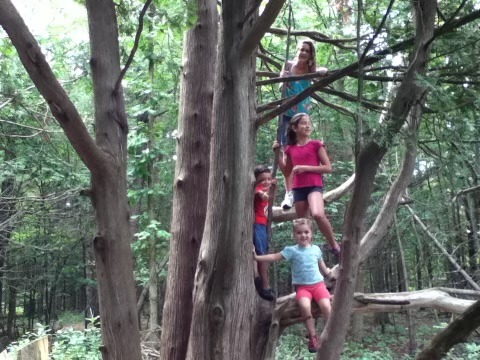
Here is a picture of me (in pink) and my sister and our two little cousins climbing a tree during a nature walk/hike in 2013 when I was 10. The song "home" brings me back to these days just exploring nature and having fun.
Thanks for sharing and reminding me of that great song!
Lea
07: The Most Captivating Composer
Hi all!
We have had a short break in conversation, but I am back today to discuss the role of music in nature and where we can find it. One of my favourite aspects of spending time emersed in the natural world is pausing to hear all the elements surrounding me and my senses. When you become still, the world continues to move around you, and you can appreciate the smallest details. Music serves a social, emotional, cultural, and cognitive purpose that can connect us to each other and to nature regardless of socioeconomic status or other potential barriers (Hookyaas, 2024). The period in which music is produced provides context into the state of the world at that time and provides the listener with context (Beck et al., 2018). Often music is a vessel that indirectly informs us of the world without the need for a lecture or reading (Beck et at., 2018). The compilation of sounds can connect all our senses and encourage us to feel something that has been left unsaid.
So where is music in nature?
Some of the greatest musicians and conductors rely on a diverse set of instruments to convey emotion through their sounds. The orchestra that nature has assembled relies upon various components and species to produce a symphony. The waves that crash upon the beach and exposed rock at impressive speeds are the percussion. They provide a base line for the remaining components to layer themselves upon. The wind provides a soft but noticeable melody with powerful acoustics as it whisks amongst the brush and trees that line the beach front. At dusk, you may hear the rustling of small creatures, scurrying about to return to their burrows providing depth to the ensemble.
I am most familiar with music in nature and have always been an observant listener, however nature in music is something I am not as familiar with. In an interview that I once watched with Finneas, Billie Ellish’s brother and co-collaborator, he explained his producing technique. He discussed his efforts to be a mindful creator and explained he often sources his beats and sounds from the world around him (Youtube, 2020). An example of this is the funky beat in the song “Bad Guy” which is part of a traffic light in Australia (Youtube, 2020). Creators such as Finneas are innovative and are exceptional interpreters of the world around them. In several Jay-Z songs such as “No Church in the Wild”, animal sounds are used for stylist purposes and make for easily identifiable songs (Jay-Z, 2011). Mainstream radio stations that play these songs are providing a platform for subtle nature interpretations. I intend to delve deeper into true nature songs and listen to how creative some songwriters are.
youtube
To wrap up my thoughts today, music makes us feel. Many of us turn to music in times of sorrow or when we need a pick me up while getting ready to play a game. Music can transform any space it enters and create an ambience that cannot be ignored. It is also the purest form of nostalgia. A personal example is the song “Home,” by Edward Sharpe and the Magnetic Zeros (Sharpe & the Magnetic Zeros, 2009). It is my camping trip anthem. Within the first few seconds, I am transported back to hikes under the hot sun, diving into the cold lake, and early morning wakeups. It is a song that represents the outdoors, family, and is ever-present in some of my fondest memories. I have included it if you are unfamiliar and in my slightly biased opinion, I think it is a must add to your summertime playlists!
youtube
References
Beck, L., Cable, T. T., & Knudson, D. M. (2018). Interpreting cultural and natural heritage: for a better world: Chapter 10 Arts in interpretation. Sagamore Venture.
Hooykaas, A. (2024). Unit 7: Nature interpretation through music. University of Guelph. https://courselink.uoguelph.ca/d2l/le/content/858004/viewContent/3640018/View
Jay-Z & West, K. (2011). No church in the wild [Song]. On Watch the throne [Album]. Def Jam Records.
Sharpe, E., & the Magnetic Zeros. (2009). Home [Song]. On Up from below [Album]. Vagrant label.
YouTube. (2020, February 4). Finneas reveals everyday sounds hidden in “Bury a friend” and “Bad guy.” YouTube. https://www.youtube.com/watch?v=I-zeJRjP6xA
5 notes
·
View notes
Text
Unit 07: Music inspired by Nature
Music is found in nature through the sounds of birds chirping, insects buzzing, animals grazing or howling, sound of water trickling down a stream, rain falling from the sky, and wind rustling through trees. If you listen carefully, you can hear nature all around you, playing its music. Throughout the years, songwriters and composers have included samples of nature in their music, bringing a sense of peace and comfort to listeners (Beck et al., 2018). Sounds of nature can be heard through real world experiences out in the forest, fields or even in your backyard. They can also be heard through artificial music production such as calming nature, or meditation rain music.
The Six Blind Men video put into perspective the differences in opinions that exist for nature interpretation. Some people look at nature and only see/hear the plants while others only see/hear the animals, but it is our role as nature interpreters to allow people to see nature as a whole, as an intertwined ecosystem filled with wonders. One of the ways to attain this is through music. Nature music or music inspired by nature can provoke feelings of calmness or serenity, while allowing us to appreciate all aspects of nature.
In the video by Ocean Mercier, I am reminded that we have always been connected to nature. Our ancestors used the stars as navigation systems, and understood the ocean for its waves and patterns leading them to new discoveries. We have always been interlocked with nature and are drawn to it for one reason or another. There is a reason why nature plays such a pivotal role in our music, we are connected to it. It brings a sense of light into our lives, the feeling of freedom when listening to it is due to the freedom we feel in nature. Our ancestors did the same.
There are so many artists that use nature in their music to relay feelings, the lumineers, Mt Joy, Caamp, Yoke Lore, Hozier, Vance Joy, Gregory Alan Isakov and so many more artists allow me to feel like I'm experiencing nature for the first time again. Bringing a sense of belonging along with excitement to be alive in such a world where we get to experience nature's wonders.
One of the songs that reminds me of nature is a song by none other than Tyler Childers, “Lady May”. At first listen it may just seem like a sad love song, but you'll hear him use imagery to paint a picture of trees, leaves, mountains and rivers. In this song, I think of him as being a tree in the forest and hoping for springtime aka the month of May to bring him warmth, therefore a love song to “Lady May”. I like this song because it is a sweet melody but it is written in a way that lets you interpret as you wish while subtly incorporating nature into it.
youtube
I wouldn't want to forget about the amazing Hozier, he is a master at provoking feelings within his music. I really love all of his songs but my favourite has to be “Would That I”. The song just reminds me of what it feels like to be free, driving down forest winding roads with the windows down. The use of imagery in this song allows you to imagine your hair being a willow tree blowing in the wind.
youtube
References:
Beck, L., Cable, T. T., & Knudson, D. M. (2018). Interpreting cultural and natural heritage: For A Better World. Sagamore Publishing.
Hooykaas, A. (2024). ENVS*3000 Nature Interpretation course notes. Retrieved March 1, 2024, from https://courselink.uoguelph.ca/d2l/le/content/858004/viewContent/3640021/View
1 note
·
View note
Text
Hi Kiera,
I enjoyed your interpretation of the interpretation of history. Your insightful post helped me further understand the importance of history in nature interpretation. I loved seeing the picture you included of the University of Guelph back in the day when it was just an agricultural school. I found myself trying to evaluate the picture to figure out where it was taken, if I can recognize some of the landscape. Every landscape that is, once was in the past. While we have urbanized it, and placed buildings on once open fields, the land still holds memories.
This makes me think, what would nature have to say if it could speak. I think nature interpreters try to voice nature in a sense. Nature interpreters learn facts and key information on various species to try and teach others. It is important to be accurate and deliver only truthful information, advocating for nature's sake. Giving nature a voice.
If ‘aggieland' could speak, what would it say?
Great post!
Lea
The Railway ‘Walked’ So The Train Could ‘Run.’
For this week, we are to unpack the quote by Edward Hyams – I found I had to read it several times to grasp the poetic wording and metaphor! In doing so, I also had to rethink its meaning each time I reread it which provided a deeper understanding. Here is how I initially unpacked the quote:
The quote begins by speaking to the idea that old items generally don’t have much worth (aside from the cool vintage finds at Value Village). Following is a seemingly different topic, integrity. Edward says that to have integrity (honesty, moral principle), one must keep together the smaller factors that come together to create the larger outcome. He then brings it back to the idea of “ancient things” by describing how the parts he is referring to are actually history or “scattered through time.” With this in mind, ancient things are indeed of importance, as the knowledge they provide upholds integrity.
In summary: History may seem unimportant, yet it provides knowledge and memory of the parts of our past that have come together to make up the whole of our present.
So, what’s this got to do with nature interpretation?
Well, every single inch of land on our Earth has a story that accompanies it and in knowing its past we are more equipped to interpret its present. For instance, the University of Guelph was once a 500-acre farm, focused purely on agriculture studies; knowing this I can see why the term “aggies” is so suited and niche to the University of Guelph (UofG, 2024). Fortunately, this information was documented and is easily accessible, along with much more information on the history of UofG. However, this is not always the case – there is often controversy on the accuracy and authenticity of history (Beck et al., 2018). This is an issue to interpreting nature in various ways, for instance, even if experts find history to be authentic, interpreters have found that visitors do not necessarily believe in the authenticity (Beck et al., 2018). If visitors do not find the interpreters' knowledge to be credible, they will be less likely to participate and enjoy the nature interpretation (Beck et al., 2018).
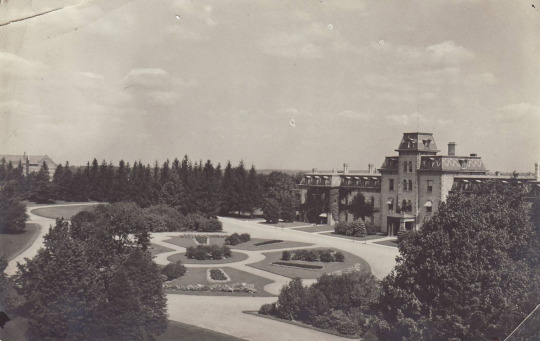
Reflecting on the implications of Edward’s words, I think how so many pieces of land, particularly land where humans do not reside and nature is the true focus, have limited documented history. I would love to learn the stories and evolution of the forestry behind my house, however this knowledge on ancient things was not documented, taking its integrity away too. This inspires myself to take pictures of nature and write about what I see, as one day when the present becomes history, I will be able to refer to the knowledge and experiences I have gained and share that with others.
To conclude for this week, I think an important takeaway is that the present would not be how it is without the past, and thus we should acknowledge both. Or, in other words, the railway ‘walked,’ so the train could ‘run.’
Thanks for tuning in,
Kiera
References
Beck, L., Cable, T. T., & Knudson, D. M. (2018). Interpreting cultural and natural heritage for a better world. Sagamore-Venture.
University of Guelph [UofG]. (2024). University of Guelph History. https://www.uoguelph.ca/about/history/
2 notes
·
View notes
Text
Blog 06: Nature Interpretation through History
“There is no peculiar merit in ancient things, but there is merit in integrity, and integrity entails the keeping together of the parts of any whole, and if these parts are scattered throughout time, then the maintenance of integrity entails a knowledge, a memory, of ancient things. …. To think, feel or act as though the past is done with, is equivalent to believing that a railway station through which our train has just passed, only existed for as long as our train was in it.”
This quote, by Edward Hyams in The Gifts of Interpretation, dives into the importance of maintaining integrity by using stories of the past. To me, integrity is about holding to your morals in a truthful and honest way. Integrity in this case is the ability to be accurate in storytelling, in nature interpretation. The ability to relay knowledge to others in a truthful and historically accurate manner. This can be done individually or collectively. We can individually dictate that we are to maintain integrity within ourselves and our nature findings, and we can as a community collectively decide that we are to be truthful and accurate in our interpretations. To take the lessons from the past and maintain them as they are.
The quote also dives into the need to integrate the past within our lives. To understand, learn and grow from the lessons learned while implementing them into our present. Not forgetting about the past simply because time has moved on. To ensure that the integrity is not forgotten. The metaphor of the train station not existing because the train had passed describes the need to integrate the past into our lives. Do not forget the lessons simply because time has moved on.
This week’s unit discussed the importance of history in nature interpretation (Hooykaas, 2024). My takeaway from the material is that we would not know much about anything if people had not begun interpreting. Nature, conservation, animals, behaviour, landscapes, would be newfound knowledge to everyone if it had not been previously documented. Those who came before us, helped the growth of our knowledge as a society. The people who first noticed a specific kind of tree, wrote it down, drew its every detail, and possibly named it, laid the path for future development. It is the interpretation from the past that has allowed us, as a growing population, to make new discoveries. History is a learning experience worth listening to.
I think it is important for everyone, in any domain of life, to relay written words in an inclusive manner, not just nature interpreters. It is essential to think of who will be reading it, what will their take away be. Sure, everyones brains interpret information differently, but the main message should be clear. Our message should have style, a touch of humour, and grab the reader's attention (Beck et al., 2018). We have the ultimate ability to relay truth and historical accuracies to allow others to interpret what they will and produce something extraordinary.
References:
Beck, L., Cable, T. T., & Knudson, D. M. (2018). Interpreting cultural and natural heritage: For A Better World. Sagamore Publishing.
Hooykaas, A (2024) Unit 6: Nature Interpretation Through History. ENVS*3000. University of Guelph
1 note
·
View note
Text
Hi Skylar,
I think your post described sunsets perfectly. The different colours of the sun’s reflection serve as a reminder that nature can create works of art. Like you mentioned, we live in a fast paced world where we are constantly running off to the next activity. We sometimes forget to take a moment to appreciate nature’s art, even something as simple as a sunset. Sunsets last typically only 10-15 minutes and there isn't one every night, so being present for a sunset is truly a gift.
I think in today's society, we are over-exposed to so many exciting things. We are always on our phones, constantly scrolling to see influencers’ amazing vacation spots, the latest trends, and always looking to do something extravagant. But maybe instead of hoping for all of that, we should just sit back and watch the sunset. Taking a moment, being present, and appreciating the world for what it provides us with.
I haven't spotted many grand sunsets this winter, so when I do see one, I make sure to cherish it and take a picture. I think taking photos of the sunset allows me to look back and reflect on the art nature has provided. Maybe subconsciously I think that taking a photo will capture the moment, visually and emotionally, allowing me to feel the way I did once again. On my way to the grocery store tonight, I saw a beautiful sunset where the sun was peeking just above the clouds. You could see the rays of sun still beaming above and it created such a beautiful sky. It reminded me that spring is coming and there will be many more sunsets to view!
I’ve attached some of my favourites :)
Thanks for sharing.
Lea

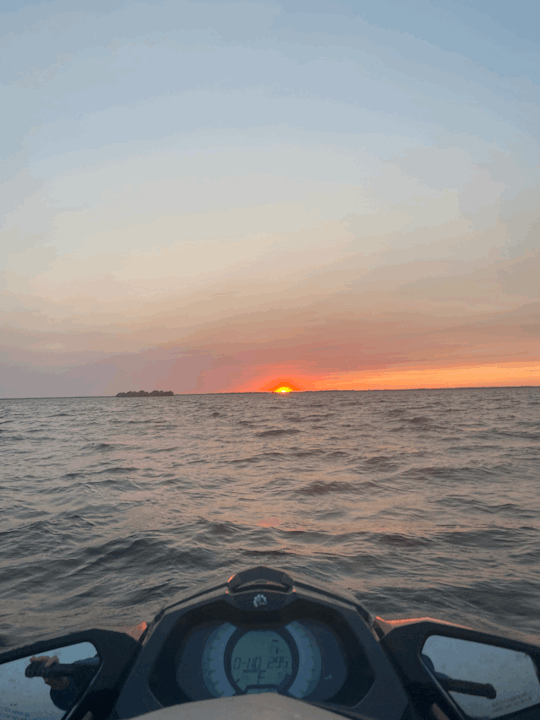
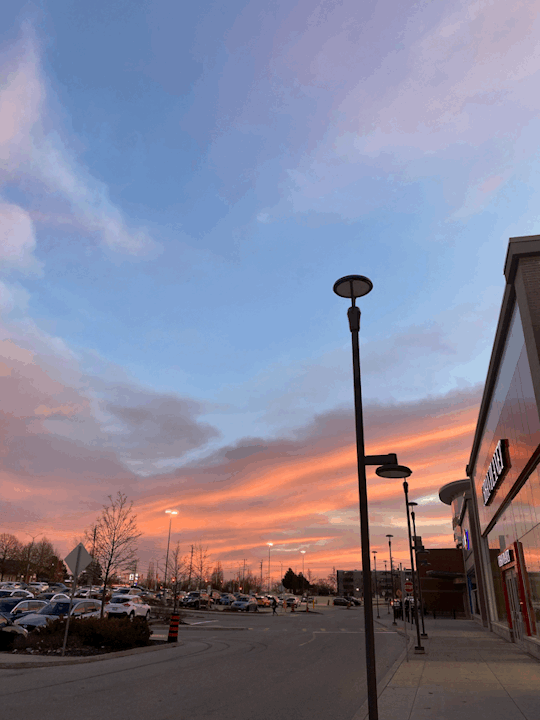

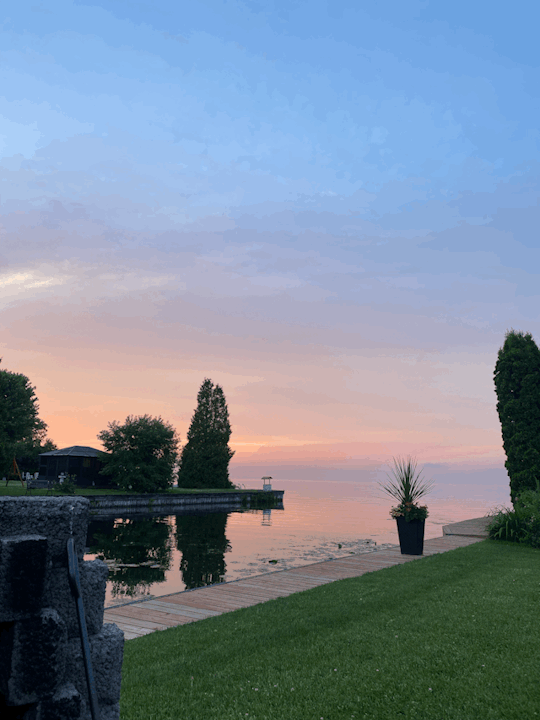
Blog 5: The beauty of Sunsets
For this week's blog post since we have the liberty to write whatever we are thinking about I thought this would be an amazing opportunity to talk about one of the beautiful wonders of the world…..Sunsets!!!
Sunsets have always held a special place in my heart. As I've journeyed through life, I've noticed that I'm not alone in this feeling. In a recent blog post discussing the interpretation of nature through art, I found that many others share my fascination with these breathtaking displays of nature's beauty. It's fascinating how something as simple as the setting sun can evoke such profound emotions and connections within us.
For me, gazing at a sunset is not just an act of observing; it's a moment of deep connection and introspection. There's something inherently calming about watching the sun dip below the horizon, painting the sky with vibrant hues of orange, pink, and purple. As the day transitions into night, I find myself enveloped in a sense of peace. It's as if the world momentarily pauses, allowing me to fully immerse myself in the beauty of the moment.
But sunsets offer more than just aesthetic pleasure; they hold profound meaning for many people. For some, they symbolize the end of a hectic day, offering a moment of rest and reflection. For others, they serve as a reminder of loved ones who have passed away (Harris & Writer, 2021). Regardless of the interpretation, sunsets have an ability to evoke a sense of awe and wonder that is unique to each person.
In a fast-paced world filled with constant noise and distraction, sunsets provide a welcome opportunity to slow down and appreciate the beauty that surrounds us. They remind us to pause, take a deep breath, and immerse ourselves in the present moment. In a way, they serve as nature's gentle reminder to cherish the fleeting moments that life offers.
As I reflect on my own experiences with sunsets, I'm reminded of the countless moments of joy, comfort, and connection they've brought into my life. Whether shared with loved ones or enjoyed alone, each sunset holds a special place in my heart, serving as a timeless reminder of the beauty and wonder of the natural world.
Sunsets are more than just a daily occurrence; they're a source of comfort, inspiration, and connection for countless individuals around the world. So, the next time you find yourself looking at a sunset, take a moment to appreciate its beauty and try to hold on to the moment you are living in. I have attached photos of some of my favourite sunsets! If you guys have any photos I would love to see them!!!!
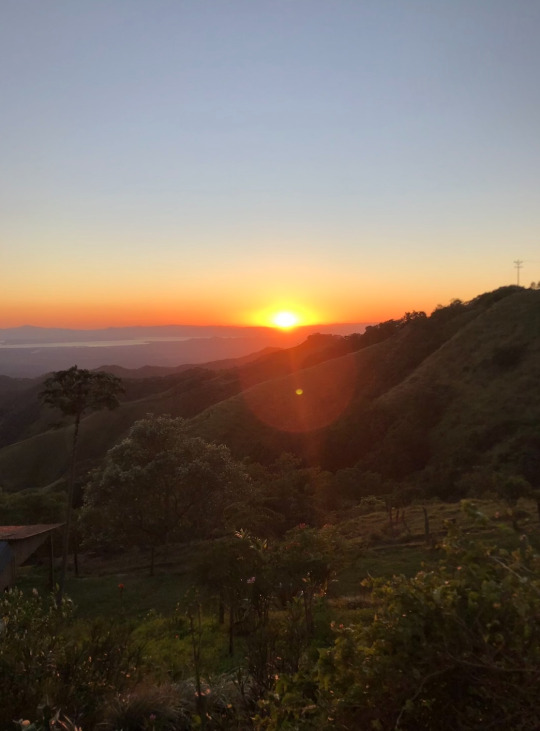

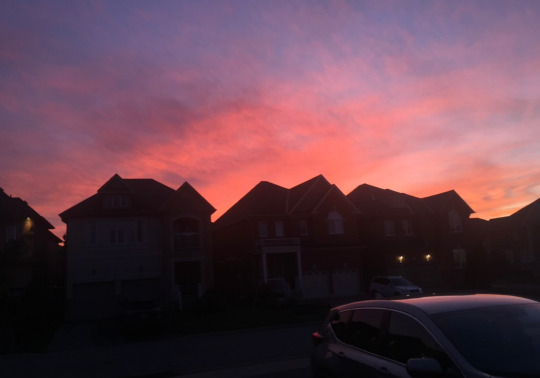
Harris, M., Writer, S. (2021). The meaning of sunsets.The Uproar. https://nashuproar.org/44574/features/the-meaning-of-sunsets/
5 notes
·
View notes
Text
Blog 05: Sustainability in Guelph
For this week's blog, I wanted to give credit where credit is due and discuss my experience with sustainability, science education, and environmental education since attending school here in Guelph.
I may have had a different experience than others at university since I am a transfer student. I completed my first year of undergrad in my home city, Carleton University. Unfortunately, my experience there was not what I expected, and I decided to change schools. I am not trying to talk badly about another institution; on the contrary, I will discuss the differences I have noticed at the University of Guelph. In the article by Wals et al., 2014, "The relationship between [science education] and [environmental education] has been characterized as "distant, competitive, predatorprey and host-parasite"' (Wals et al., 2014). This statement is false because I see science and the environment intertwined daily into my student life at UofG.
Since moving here in my second year, I noticed a dramatic positive difference in sustainability regarding student involvement, campus greenery, and the city itself. I came to Guelph unaware of the students, residents, and organizations' efforts toward sustainable living and have since been pleasantly surprised. There are many different student-run events like Drop and Cop, UofG Free Store, and UofG Food Market, to name a few, which incorporate sustainable practices and educate others simultaneously. These clubs and organizations actively use sustainable methods to invite students to shop for clothing, supplies, and local produce in an environmentally friendly way. There are so many more organizations and events led by students at the university that are typically posted on the sustainableuofg instagram account. I recommend going to check it out if you haven't already. The university has additionally been awarded a gold rating for sustainability, according to the Association for the Advancement of Sustainability in Higher Education (UofG News, 2022). That's something to be incredibly proud of.
The amount of greenery on campus stood out to me when I first got here. We have beautiful mature trees in front of Johnston Greene, vines crawling on the UC and Hutt building, multiple greenhouses, a blooming garden in front of the conservatory, and a gigantic arboretum right down the street. This is not all, but some of my favourites. It is clear that the university has made an effort to incorporate nature in all its forms onto campus. The comparison between the two campuses I have been to is incredible. I also wanted to mention the variety of classes offered here at Guelph that focus on climate and environmental sustainability while incorporating actual science. Take it from me, someone who has seen the courses at another university; they don't do it like UofG. I have taken classes focusing on climate change, conservation, geology, and environmental science, and I am just a Biological Science major. The courses offered here teach students about real-world issues and implement real science to back them up. I took ENVS 3010 Climate Change Biology last semester, which truly opened my eyes. Seeing that climate change is not just a conversation to have, but an actual, scientifically backed up issue that needs urgent change. The incorporation of science and environment is inspirational here at UofG.
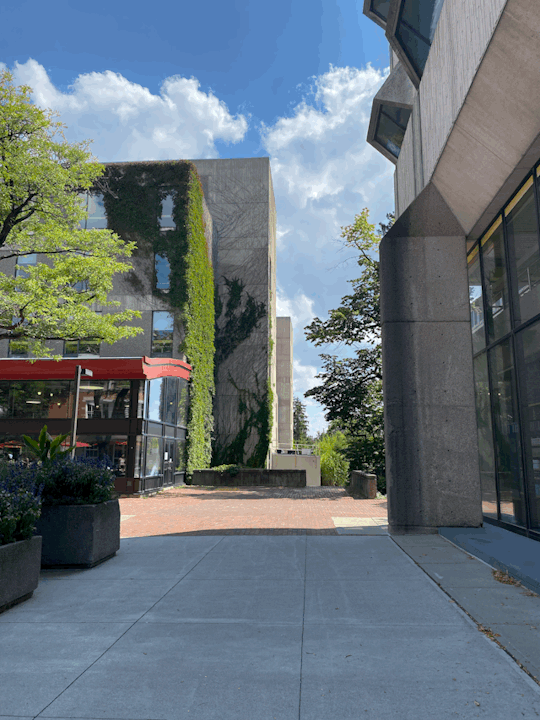
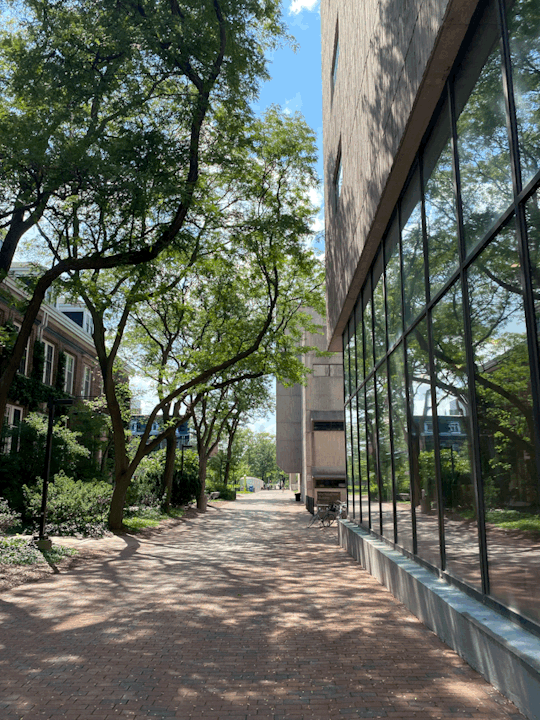
The city has actively engaged the community in sustainability efforts. I've spent my Saturday mornings at the farmers' markets in downtown Guelph, which feature many local farmers and entrepreneurs to support the local economy. Additionally, Guelph has many thrift stores, some vintage and some contemporary, all promoting sustainability in fashion. There has been an increasing trend in thrifting, which is an amazing trend to have on the rise. I admit I love to shop, so having a variety of thrift stores available to me allows me to shop in an affordable and sustainable way. I was also impressed to see electric buses driving around Guelph—a sight rarely seen in Ottawa. Since many students don't have cars, taking the bus is an everyday occurrence, and introducing electric buses is a significant step towards a cleaner environment.
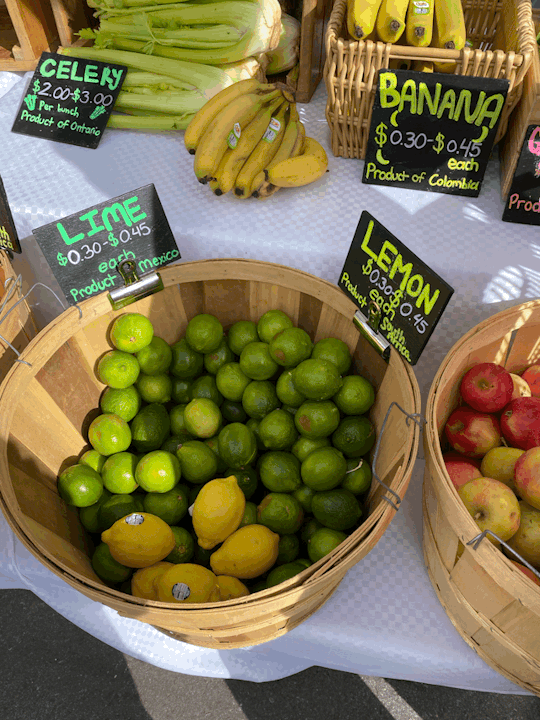
Anyway, I just wanted to acknowledge the efforts and give credit where it is due—well done, UofG and the city of Guelph.
References:
UofG News. (2022). U of G Earns Gold Rating for Sustainability. Accessed February 8th, 2024. https://news.uoguelph.ca/2020/11/u-of-g-earns-gold-rating-for-sustainability/
Wals, A. E. J., Brody, M., Dillon, J., and Stevenson, R. B. (2014). Convergence Between Science and Environmental Education. Science, 344(6184): 583-584. https://doi.org/10.1126/science.1250515.
1 note
·
View note
Text
Hi Heather,
I enjoyed your take on nature and art. I also enjoyed seeing your talent for interpreting nature through paintings. I have minimal artistic abilities, so I enjoy seeing how others who are gifted in the arts perceive the world around them and put it onto a canvas. The memory you shared of you and your grandmother painting together demonstrates how everyone interprets nature differently; it's a unique experience for everyone. I think that's what makes nature a true form of art. There are so many takeaways from nature that can be interpreted differently.
You mentioned how art is displayed in museums or galleries, which shows how important art is. Throughout history, art has been preserved because it is unique. One person's interpretation of a landscape can be different from another, and that's what makes art so interesting. You can feel more than just appreciation when looking at art, you can learn, understand, empathize, and fall within it. You can see a painting and feel like you've been there—a sense of belonging. Art galleries allow people to come and view art and interpret it individually as they please.
“For the greatest artists do not make their best works of art in clay or paint or sound or words; they make them right inside us, within the heart of the reader or audience,” - Jay Griffiths (2013) (Beck et al., 2018).
I recently visited the National Art Gallery in Ottawa and found a few paintings that interpreted nature through art. I have included some pictures of the paintings that allowed me to feel part of the landscape.
Thank you for your post!
Lea

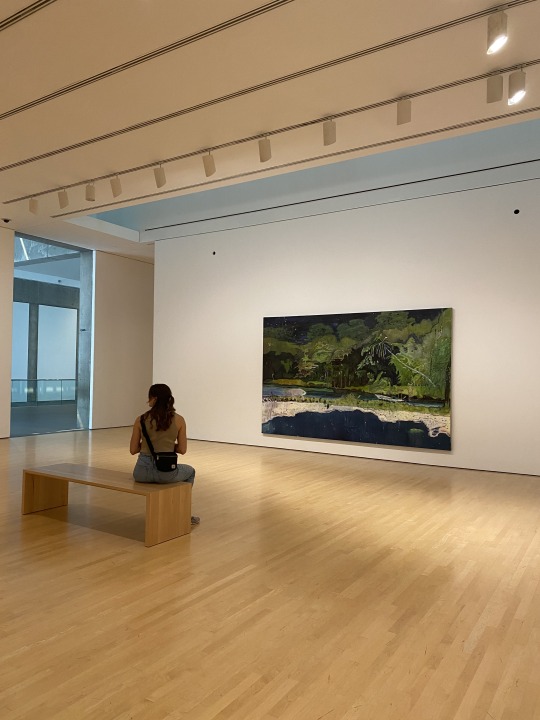
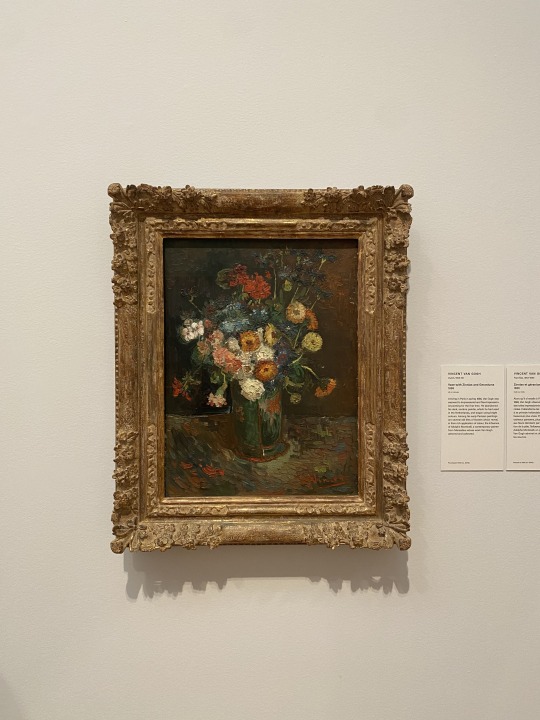
References
Beck, L., Cable, T. T., & Knudson, D. M. (2019). Interpreting cultural and natural heritage: For A Better World. Sagamore Publishing.
If you look at the word NATURE, you'll find A R T in it :)
Hi folks,
This weeks lecture notes and readings was definitely my favourite so far. For as long as I can remember I have been drawn to the arts, participating in painting, drawing and music (on and off) my whole life. When I got older, I started to appreciate the beauty of nature and connected it to my painting. My grandmother was a great inspiration throughout this journey, she had a great eye for art and would always take me up on my offer to paint. This was also the first time I noticed how two people can look at the same landscape and see completely different things. I remember sitting beside a river with my grandmother, we were painting with watercolour. At one point I looked away from my canvas to see hers and was, honestly, a little confused. When I looked at the river, I had focused my painting on the waterfall, and the waters descent over the rocks. But hers was different, hers was of the entire landscape, the river was only a small part of it. We were looking at the same scene but were interpreting it in different ways. Neither was wrong, neither was right either, it was simply how we saw it.
When looking at the question posed to us this week, I honestly had no idea was the first part meant, and there's a good chance I might still be confused. "Who are you to interpret nature through art?". It seems to me like an intimidating question, and trying to come up with a definitive answer, that I could simply state, escaped me. I interpret nature through art because I am human and because I can. I interpret nature through art because I resonate with the idea that "people perceive natural resources and artistic values emotionally as well as intellectually" (Hooykaas, 2023). When looking at a natural setting, I feel the urge to sit for a moment and appreciate the beauty. I also, usually, want to take out my phone and capture the scene, so I can continue to appreciate it.
When it comes to interpreting "the gift of beauty" I have always gravitated to painting. I enjoy painting scenes that I have taken pictures of, moving them from screen to canvas, and reminiscing in the memory. Using art as a tool to help convey a message allows us to create richer experiences for those we are sharing it with (Wheeler, 2016). For example, when I go to visit my grandmother I tell her about my life and what I've been up to, and on many occasions I will have painted a recent memory from where I've been, and I can tell her "I was up at the cottage and there was the most beautiful sunset", but the addition of me showing her the scene as I remember it makes the connection so much more meaningful.
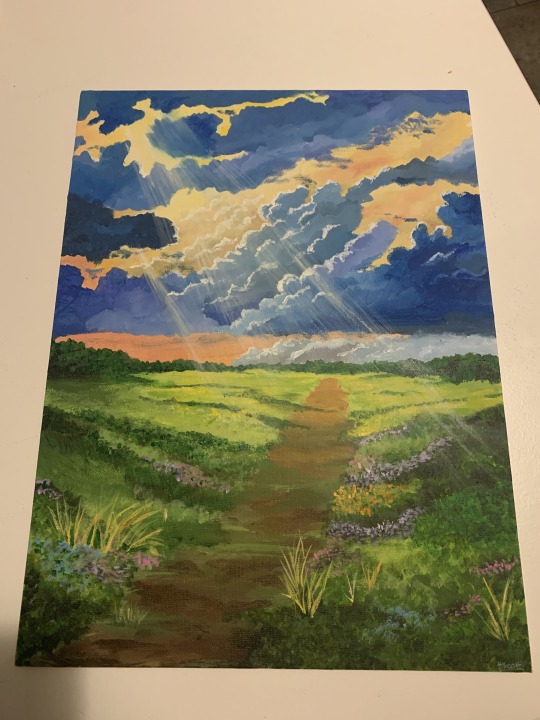
In chapter 10 of our textbook we were given a debrief of the main types of art; interpretive theater, storytelling and poetry, music, dance and the visual arts (Beck et al., 2018). Not everyone will react the same way to each of these mediums, but they are all effective tools in interpreting nature to the general public. I find music, visual arts and poetry the most effective, but someone else might disagree. It's all in the eye of the beholder, which is why it’s so important for us as interpreters to ensure we offer as many as possible. I've done activities with students where we go out on a walk and at some point stop and everyone has to draw something they see around them. This makes them stop and think about where they are and what they’re seeing. Most of the time, they will pick something that stands out to them or something they think is cool or beautiful. Just by doing a simple activity like that, a connection is bridged between the student and their environment.
My family has several The Group of Seven paintings in our home, my parents always loved the appreciation of art. I love the paintings because they are all done very simply, the style is almost gentle and it is calming to look at. The painting are also very important, not everyone has the ability to venture out into the natural world to appreciate those scenes first hand. However, galleries are accessible to almost everyone and they are everywhere. Someone can look at a mountain first hand, capture the moment on paper, interpreting it how they see it, and then share it with those who can't go themselves. In this way, we are in our simplest human form, seeing something beautiful, appreciating it, and acting on the urge to share it with others.
-All for now!
Beck, L., Cable, T. T., & Knudson, D. M. (2018). Interpreting cultural and natural heritage: For A Better World. SAGAMORE Publishing.
Hooykaas, A. (2023). Unit 04: Nature Interpretation through Art and Planning for "All" Scenarios [Lecture notes]. ENVS3000 Nature Interpretation. University of Guelph.
Wheeler, E. (2016). The craft of engagement. Legacy, 27(6), 29–31.
3 notes
·
View notes
Text
Blog 04: Art within nature
"Art is in the eye of the beholder."
― E.A. Bucchianeri
This quote represents the role of art, which provides a medium for people to enjoy, learn, and interpret on their own. Interpreting nature works similarly, we observe its beauty and interpret it uniquely.
When reflecting on the readings, I realized that nature interpreters help people view nature as art. This specific sentence stood out to me, "An interpreter assists people as they move through these stages so that eventually the individual will not only perceive beauty in spectacular mountain scenery but also will find beauty and inspiration in tall-grass prairies and tidal flats as well" (Beck et al., 2018). This sentence describes the role nature interpreters have, to provide a new outlook on nature in all its beauty, regardless of whether it is a beautiful waterfall or flowers in a neighbour's garden. It gives people a new perspective and allows them to appreciate the gift of beauty provided by nature.
"The gift of beauty" is not a physical gift, but rather, it is a concept that goes beyond mere visual appeal, encompassing the sensory, emotional, and intellectual aspects of human experience within nature (Beck et al., 2018). My interpretation of the gift of beauty is seeing animals and plants interact with one another in an ecosystem. I enjoy seeing the invisible threads holding them together and admiring the art they produce. My most recent appreciation is from my trip to Florida during the winter break. I visited New Smyrna Beach and walked along the trail surrounding the natural dunes. It was the first time I had ever seen sand dunes, so it was a really amazing experience.
I got to see turtles bathing in the sun, sitting right above their nests. Their nests were made by digging tunnels in the natural sand dunes. I believe that the plants growing within the sand provide enough support so the sand doesn't come crashing down on the turtle below. The combination of the natural forces of the wind creating sand dunes and the turtles using it as a home really brought attention to the symbiosis. Additionally, sandpipers were strolling along the beach, foraging little insects they found when the tide rolled out. A relationship between animals and nature that can give insight into the world's beauty. The sand dunes were an amazing sight to see because I could spot the wind patterns within the sand. You could see waves in the sand from where the wind blew, creating a beautiful piece of art onto the natural canvas.
I think I noticed many of these details because I have had the privilege of learning about animals, plants, and nature in school. I can appreciate the little things nature has to offer and notice the art it provides. It is now my responsibility to point it out to others. To show others examples of beauty and to allow them to interpret it in the way they desire. "Interpretation is art, being able to relay information to inspire others" (Beck et al., 2018).
I have attached pictures of the sand dunes, I hope you guys enjoy seeing it just as much as I did :)
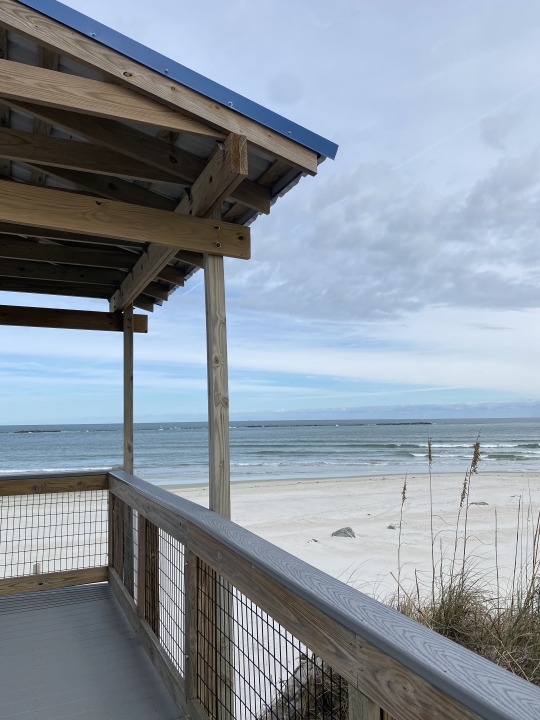


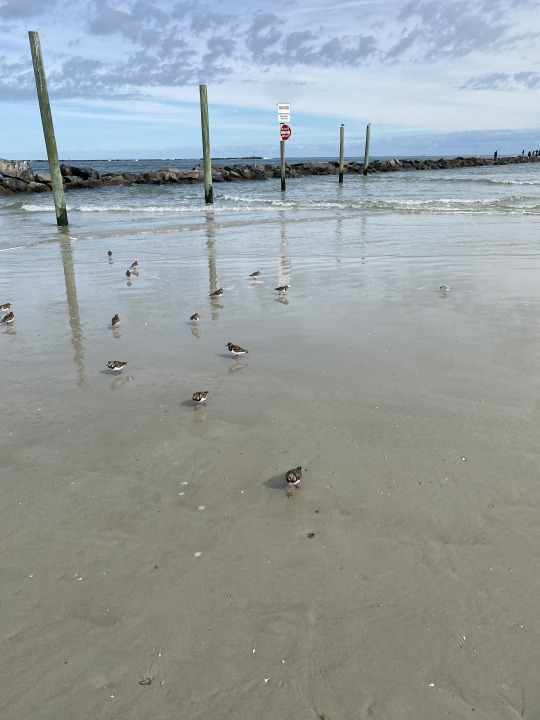
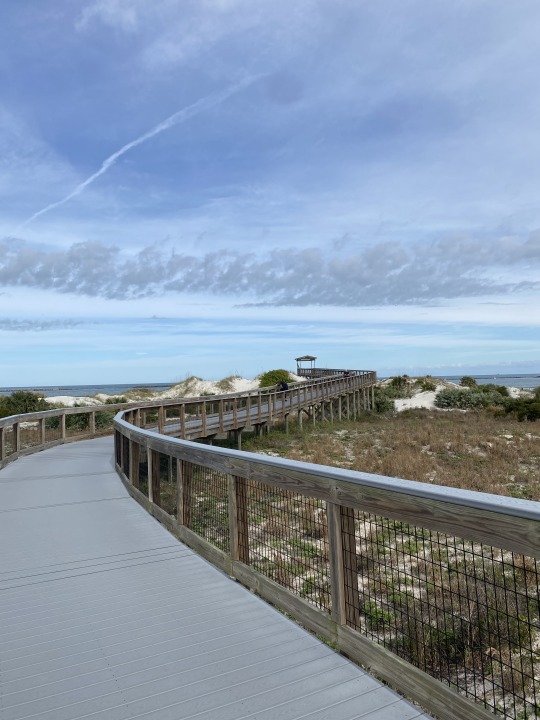
References
Beck, L., Cable, T. T., & Knudson, D. M. (2019). Interpreting cultural and natural heritage: For A Better World. Sagamore Publishing.
4 notes
·
View notes
Text
Hi Joe,
I enjoyed reading your thoughts on privilege and what that means for nature interpretation. Being a Canadian really is a privilege for many reasons as you stated. We have the opportunity to have passports, most of us have had one since a young age from our parents filling out that endless paperwork, but some don't have that privilege due to various reasons. I think having a passport is an immense privilege because not only are there accelerated lines but additionally we have the ability to travel without a visa for extended periods of time and have access to so many different countries. Another piece of identification many of us have is a driver's licence. We have the ability to travel in cars, get to the grocery store that is 5 minutes away or take a road trip across Canada. Sometimes we forget the little things that grant us privilege because we are so used to having that privilege, it's been a part of our lives for a long time. Both a passport and a drivers licence grant us a feeling of ‘freedom’. I believe that as nature interpreters, we have the opportunity to grant that same feeling of freedom or escape by removing barriers. We have the ability to remove barriers towards limited background knowledge, age, race, gender, language and disability. If we can allow participants to experience a barrier free experience in our nature tours, we can grant them that feeling of freedom regardless of privilege.
Thank you for your post!
Lea
What role does “privilege” play in nature interpretation?
We’ve definitely discussed some heavy topics in this unit, however, it's important to shed light on these hardships.
For me, I would define privilege very similarly to how it was described with the unit 3 material. I think that privilege means having some sort of advantage over another, in general I typically think this means having an opportunity or obtaining something that's not available to everyone equally. I really like how it was discussed within the unit and referred to as an “invisible backpack” where one can utilize unearned assets that not everyone has access to (Hooykaas, 2024). The idea of these assets being unearned is really important to emphasize, as privilege is certainly something that one can be born into. I think about the example of having a Canadian Passport. I’ve recently done some traveling, going across to the US and even Australia. There are signs at the customs and border crossing lines that divide individuals by the passports that they hold. I’ve noticed that there are lines for Canadian passport holders, along with a few other countries, that have their own essentially accelerated lines. This is interesting to me considering I did absolutely nothing to receive a Canadian passport yet still receive this privileged treatment.
With regards to privilege and how it pertains to nature interpretation, I think we’re all very lucky in Canada to have access to a variety of nature sites and parks. This can be seen specifically when looking at locations such as Guelph. I have access to areas like the Arboretum, Guelph Lake, Speed River, and a variety of hiking trails and forested areas nearby. Additionally, many areas around southern Ontario are like this, and not too far away. Looking at Canada as a whole, there are isolated communities in Northern Canada which might not have the same availability to nature as we have here, and we need to recognize this as a privilege. .
Additionally, when discussing nature interpretation it’s important to recognize the educational aspect that we’re exposed to, specifically as an environmental science student. Because of the different classes and labs I’ve been able to attend, I’ve likely been able to learn more about natural processes and phenomena than the average person. Personally, when I leave the house, I can identify a variety of plant species and fully absorb what's going on around me. I can make connections between what I’m seeing and what I’ve learned in class. This certainly comes with a high degree of privilege as many don’t have the opportunity to learn about these ideas, let alone make connections between what they’re learning and their real lives.
I would love to hear everyone else's thoughts on this! I know I talked a little bit about my experience as an environmental science student, and how being able to apply and observe what I’ve learned in the classroom is a privilege, however I know many of us are in a variety of degrees. For those not in environmental science, how do you think your education has or hasn't impacted your ability to interpret nature?
References
Hooykaas, A. (2024).Hooykaas, A. (2024). ENVS*3000 Nature Interpretation course notes. Retrieved January 23, 2024, from https://courselink.uoguelph.ca/d2l/le/content/858004/viewContent/3640017/View
8 notes
·
View notes
Text
Blog 03: Privilege in nature interpretation
Privilege is having opportunities others might not. As a white university student, middle-class, bilingual French-English Canadian, I have opportunities others do not. The opportunity to attend university is granted by my ability to work full-time while living with my parents in the summer to make money for the school year. Some people may have physical, emotional, or distance-related barriers that prevent them from saving up money by living with their parents in the summer. Attending university is a privilege as I can learn various subjects and add them to my invisible backpack. Due to my university experience, I have the opportunity to learn about animals, plants, the environment, ecosystems, and the careers I can pursue in a field that I desire. As a nature interpreter, it is crucial to ensure that regardless of participants' knowledge, they feel included and welcomed. Participants can understand the interpretation by reducing the use of complex scientific terms and using age-appropriate language. "Acceptance or rejection of messages ultimately lies with the visitor," therefore ensuring that they have a chance to learn as much as possible in a safe and welcoming environment by removing barriers such as background knowledge (Beck et al., 2018).
I also have the privilege of speaking two languages, my mother speaks French and my father speaks English. Granted, divorced parents are not always optimal, but having the ability to speak two different languages in two different households is a gift. A nature interpreter's most excellent skill is communicating, so having the option to speak either language is extremely helpful. As a nature interpreter, my ability to cater to various participants in either language can make their visit more enjoyable and remove language barriers. Additionally, adding signage, written text accompanying audio, braille and additional text aid for those with barriers. "Nonparticipants […] want to participate, but encounter real or perceived barriers," and thereby removing such barriers to language, hearing, or sight, a greater range of participants will visit and experience will be better (Beck et al., 2018).
I have been fortunate enough to visit different parts of the world with my family and see different animals, ecosystems, and nature trails. I have had the opportunity and privilege to visit different nature interpretation sites to learn how nature interpretation works with privilege. For example, over the Christmas break, my family visited Florida, and we decided to take an airboat tour to see the alligators in the marshes of Lake Tohopekaliga. The guide, Willy, was interactive and often stopped the boat to point out alligators, birds, different plants within the marsh, and the types of trees on the border. The airboat had roughly 15 people: children, young adults, and older adults. Willy provided a great tour by speaking in plain language but additionally providing concrete scientific facts. He was able to answer many questions and relate some of them to his own experiences to make the participants feel welcome. They also had pamphlets about the different species seen throughout the tour in the check-in building that were available before the tour. At the end of the tour, he brought over a baby alligator for each of the participants to hold as a final activity after the airboat tour. I believe that the airboat tour was well done since it adhered to The Visitor's Bill of Rights. "The Visitor's Bill of Rights," by Robert Fudge, states that visitors have the right "To have their privacy and independence respected (Interpretation should not be inflicted on visitors), to retain and express their own values, to be treated with courtesy and consideration, and to receive accurate and balanced information," (Beck et al., 2018).
I have included some pictures of the airboat tour.
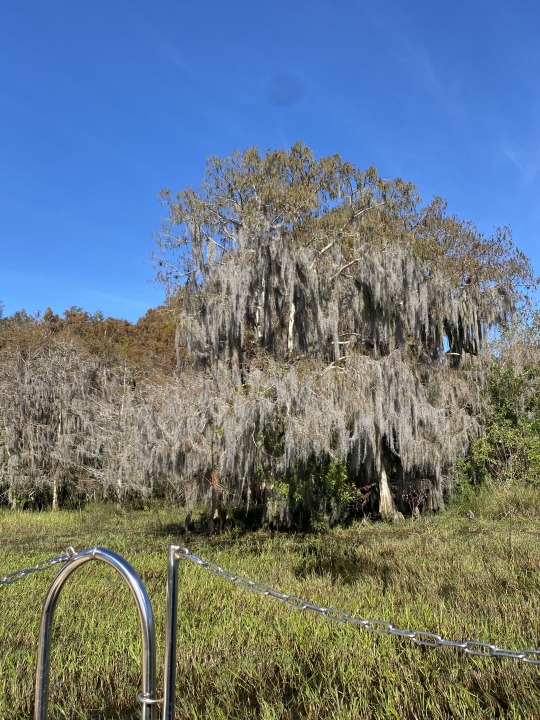
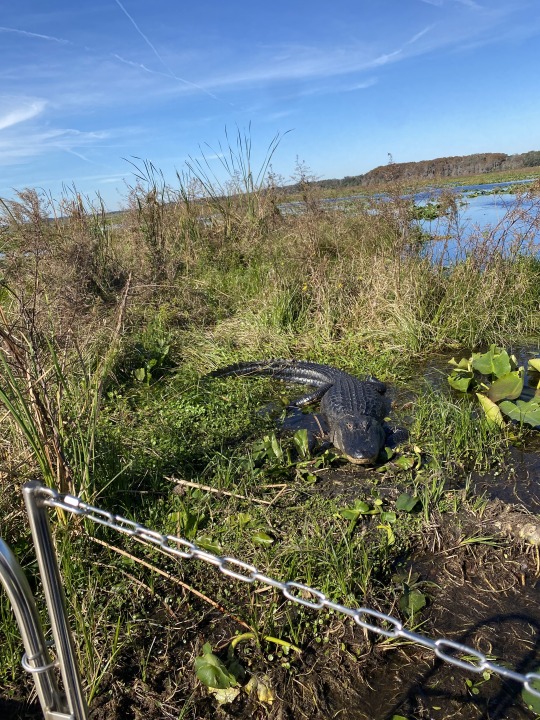
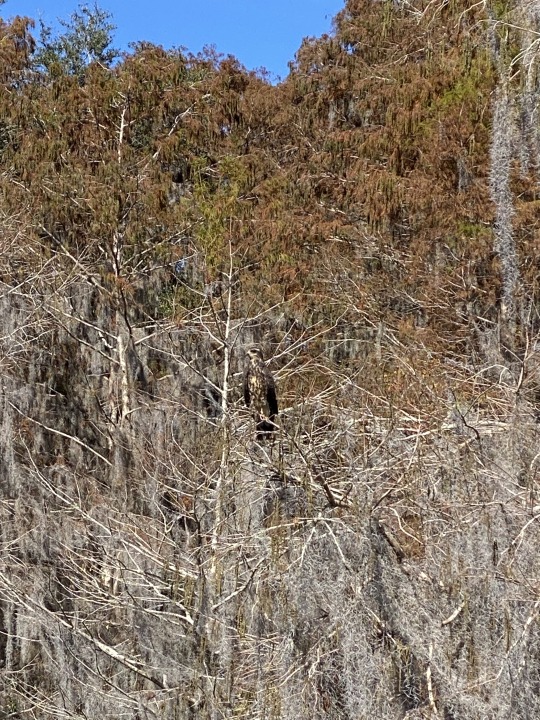

References
Beck, L., Cable, T. T., & Knudson, D. M. (2019). Interpreting cultural and natural heritage: For A Better World. Sagamore Publishing.
0 notes
Text
Hey, thanks for sharing your ideal role!
I found your post inspiring as I, too, care deeply about the rising effects of climate change. Your role could raise awareness of the devastating impact on the ecosystems to those who might not understand its urgency. People tend to walk through their local nature trails and not notice the small but significant effects of greenhouse gases. Leading people through their local trails and pointing out what is happening could open their eyes.
This idea caters well to visual learners, those who need to see the effects for it to become real to them. Raising awareness in this regard is beneficial to see change in the climate crisis. Sometimes, reading updates on climate change online can seem distant and a later issue; therefore, allowing people to see the effects in person can be personalized. I think we will see many more roles like this pop up as climate change worsens. I would love to go on one of your guided tours.
I like that you brought up the TORE approach by Sam Ham, as it encompasses four great skills needed as a nature interpreter (Beck et al., 2018). Being informative on the issue while making it an exciting guide. Additionally, using the NNOCCI strategy to provide informational metaphors and at-home solutions that people can implement in their daily lives can make people feel connected to the climate issue (Beck et al., 2018). Sometimes, thinking about YOUR implications to climate change is an effective way to start change. We all play a role in rising global temperatures.
References
Beck, L., Cable, T. T., & Knudson, D. M. (2018). Interpreting cultural and natural heritage: For a better world (1st ed.). Sagamore Publishing.
Blog Post # 2 - My Ideal Role As An Environmental Interpreter
With the effects of climate change on our planet increasing daily, it’s never been more important for people to understand the magnitude and urgency of the issue. As an individual who is pursuing a career in Environmental Sciences, I believe I must appreciate, protect, and educate others on the impacts of the climate crisis. My ideal role as an environmental interpreter is to create a guided tour of nature that displays the real-time local effects of climate change on our environment. To create this guided tour, I will use Sam Ham’s TORE approach to nature interpretation described in Interpreting Cultural and Natural Heritage: For A Better World by Beck et al. (2019). The TORE approach stands for thematic, organized, relevant and enjoyable. This approach will help me create the tour in a way that will make the experience exciting, interesting but also educational and meaningful. Hopefully, by the end of the tour, individuals will feel informed enough to educate others on the issue.
I feel if I can demonstrate how climate change is/will impact areas people live around, they will have more incentives to take action. Most of the major impacts currently caused by climate change are in countries that usually emit the least amount of greenhouse gases. If individuals who live in the countries that produce the most greenhouse gases can see their environments are also affected, maybe a greater sense of urgency will develop within them to act against climate change.
An important skill needed to achieve my goal is strong communication skills. Climate change is a very controversial topic for some. Effectively communicating the topic will require excellent communication skills. To effectively communicate a message to my audience I will follow the National Network for Ocean and Climate Change Interpretation (NNOCCI) strategy for discussing climate change as described in Interpreting Cultural and Natural Heritage: For A Better World by Beck et al. (2019). This strategy involves maintaining a neutral tone, stating why the issue matters and the background, using explanatory metaphors to help close gaps in knowledge, using explanatory chains to help show that the issues are connected to climate change, and finally, using community-level solutions which involves explaining to the audience as citizens rather than consumers. By utilizing strategy, I hope to be able to inform individuals about climate change without offending anyone.
Other skills I will need to run my tour effectively are strong research skills and knowledge-based science skills. Climate change is a very complex process, and as a tour guide, I must be able to answer people’s questions as they arise or refer them to a source that may have an answer. Additionally, as the tour is locally based, I must have a very strong understanding of how climate change affects our local environments or how it may affect them in the future. For example, knowing how climate change can affect biodiversity, habitat structures, and species interactions in local ecosystems, and how this may affect the audience in their everyday lives, will be essential for the tour. This process will also require good teaching skills. As mentioned, the participants will hopefully feel informed enough to educate others.
In conclusion, as an individual dedicated to the field of Environmental Sciences, I am compelled to address the ever-increasing impacts of climate change by creating an immersive educational experience through guided nature tours. The urgency of the climate crisis requires a comprehensive understanding of its magnitude, and my role as an environmental interpreter is rooted in appreciation, protection, and education. Hopefully, with the creation of my nature tour, I can show the importance of taking action against climate change using local environments as examples to convey my message.
References
Beck, L., Cable, T. T., & Knudson, D. M. (2019). Interpreting cultural and natural heritage: For A Better World. Sagamore Publishing.
1 note
·
View note
Text
Blog 02: My ideal interpreter role
My ideal role as an environmental interpreter would be writing periodic editorial columns for various research journals. Although the role of a nature interpreter is commonly thought of as being a tour guide or a landscape expert, there are also storytellers who communicate experimental findings through editorial research journals. My personal favourite is the Journal of Experimental Biology. The types of articles noted as 'inside/outside JEB' are editorials written by scientists who interpret the primary research articles and deliver short synapses on what they entail. These editorials invite readers with different educational backgrounds into the world of comparative animal physiology, molecular biology, and much more. The editorials are provided in simple language and are easy to read without the complex scientific jargon. The way they are written aids people who are looking to learn about science or those who are looking for a quick summary of the research paper. Additionally, images are always posted along the editorials to give insight into the topic and cater to the different learning styles.
As a visual learner, reading primary research articles can be difficult as, most times, there are not many visual aids. Visual aids like graphs, tables, and images for context are helpful for me to retain information. Creating editorials with pictures and labels of various animals or plants could help others who learn through visual learning. I am also an active learner, meaning I enjoy relaying the information I have recently discovered. Sometimes, I tell my family about facts I have learned in class. As an introvert, public speaking is not my strong suit, so being an active learner is difficult at times. I struggle to express my knowledge and deliver interesting and informative aspects within the environmental field to people I don't know, and therefore, writing them out in scientific journals can help me in that regard.
My role would entail working for the journal as a writer to interpret the science from the research paper. I would love to work on local research done here in Guelph. I could become an interpreter who simplifies the research for those interested, regardless of their scientific knowledge. I could implement an audio version that summarizes the editorial to cater to the auditory learners. I am also aiding the sensing learners who enjoy reading facts about real-world applications since most of the research papers are based on comparative animal structures and how they function.
I am passionate about animals and the environment, so by combining both of my passions makes me content and having the ability to impact others makes this role inspiring. Many people may not know that this role exists so advertising it could help not only myself, but raise awareness and funding for researchers and their work.
The skills needed for this job are mainly the ability to identify important aspects of research papers while highlighting their importance- answering the big 'why should I care' question. It also requires communicating clearly what the goal of the research is and summarizing it into plain, engaging, and entertaining text.
0 notes